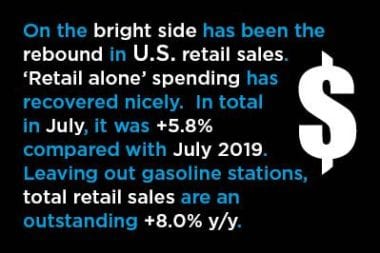By: Alex Carrick on August 17th, 2020
Writing the latest mid-month Nuggets report has taken me on an interesting journey. You’ll notice that point (1) begins on a sour note, but quickly shifts gear. Many of the bullet points that follow also take up and down trajectories. Be sure to see my wrap-up conclusions in (14).
(1) Given that the U.S. economy in total has been doing so bad, i.e., -32.4% quarter-to-quarter annualized change in gross domestic product (GDP) in Q2 of this year, it’s hard to imagine there might be significant pockets of strength sprinkled throughout. Surprisingly, though, there are. Most apparent, and seemingly discordant, is how well stock market indices have been doing. Justification can be found in the high-tech sector.
(2) To the extent the economy has been saved from an even worse fate, it’s been high-tech advances in communications (e.g., video conferencing that facilitates both working from home and the maintenance of personal connections), ‘big data’ management and logistics that have enabled many firms to survive when their initial prospects, as the coronavirus sprouted in early spring, appeared quite unfavorable. Investment managers have been padding their portfolios with shares of Facebook, Amazon, Apple, Microsoft, and Google/Alphabet. Nevertheless, be aware that earnings reports (or more accurately, loss reports) to be released over the next several weeks, for many publicly traded firms, will be ugly.
(3) Also, on the bright side, has been the rebound in retail sales. Monthly, the Census Bureau issues an Advance Sales for Retail and Food Services report. Expenditures at food services and drinking places (-18.9% year over year) continue to be only a shadow of what they once were. States have been gradually easing restrictions on restaurants, but seating is spread out or relegated to patios. High-profile instances of uninhibited mingling in bars, leading to upticks in COVID-19 infection rates, have threatened the progress made in re-booting the hospitality sector.
(4) ‘Retail alone’ spending, on the other hand, has recovered nicely. In total in July, it was +5.8% compared with July 2019. Leaving out gasoline stations, where receipts have been reduced by the year-over-year plunge in the price of petrol, total retail sales are an outstanding +8.0% y/y. Among shopkeeper categories, only ‘clothing and accessory’ stores, with sales of -20.9% y/y, remain deeply in the doldrums.
(5) From Graph 1, ‘nonstore retailer’ sales are an amazing +24.7% year over year. The shift to online shopping, and away from ‘bricks and mortar’ locations has been accelerated by the pandemic and earlier ‘stay at home’ directives. Comprising 90% of ‘nonstore retail’ sales is a subset with the designation, ‘electronic shopping and mail order houses.’ Data for the latter is a month behind the other retail sales categories. For June, ‘electronic and mail order house’ sales were +29.4% y/y. In May, at their fastest year-over-year pace, they had been up by more than a third, +35.1%.
(6) In July, three shopkeeper categories on their own accounted for more than half (55%) of all U.S. retail sales: motor vehicle and parts, with a 23% share; nonstore retailers, 17%; and food and beverage stores, 15%.
Graph 1: U.S. Retail & Food Services Sales Y/Y ‒ July, 2020

Chart: ConstructConnect.
(7) Another subgrouping of shopkeepers looks at sales that are often closely tied to home ownership or residential real estate activity. This gathering of three combined for 11.1% of total retail sales in July: ‘furniture and home furnishings,’ 2.0%; ‘electronics and appliances,’ 1.6%, and ‘building materials and garden equipment,’ 7.5%. Their respective year-over-year percentage changes in sales in July were -0.7%, -2.8%, and +14.8%.
(8) ‘Building material and garden equipment’ sales have barely suffered harm over the past five months. ‘Furniture and fixture’ and ‘electronics and appliance’ store sales, however, have recovered from some truly horrendous year-over-year results back in April, -59.1% and -43.4% respectively.
Graph 2: U.S. Home-Related Retail Sales Y/Y

Based on ‘current’ (i.e., not adjusted for inflation) dollars. Latest data points are for July 2020.
Adjustments are for seasonal variation, holiday and trading day differences, but not for price changes.
Chart: ConstructConnect.
(9) July’s Purchasing Managers’ Index (PMI) of the Institute for Supply Management (ISM) climbed to 54.2% from 52.6% in June. A figure above 42.8% indicates that both the total economy and the manufacturing sector are expanding. A PMI reading of 54.2% has historically corresponded with +3.3% ‘real’ (after-inflation) gross domestic product (GDP) growth, annualized.
(10) The PMI of the ISM bottomed out at 41.5% in April of this year. April was also when the capacity utilization rate of U.S. manufacturing sank to its lowest, only 60.0%. By July, according to the Federal Reserve, manufacturing’s capacity usage was back close to 70.0%.
(11) Existing home sales in the U.S. recorded their biggest month-to-month increase ever (based on statistics going back to 1968) in June, +20.7%, as calculated by the National Association of Realtors (NAR). The seasonally adjusted volume of single-family, condo, and co-op homes was 4.72 million units. Here we have a perfect example of why it’s so hard to interpret the latest data. June’s big percentage jump was achieved on top of a May number (3.91 million units) that was the lowest since October 2010. Furthermore, unit sales in June 2020 were still -11.3% compared with June 2019. The NAR says the year-over-year climb in the ‘median’ price (i.e., half lower and half higher) of existing homes sold is presently +3.5% countrywide, with the West leading the way, +5.4%.
(12) Paying no heed whatsoever to the massive job losses that have occurred north of the border, similar to what has transpired south of the border, homebuilders in Canada have ramped up their groundbreakings. Canadian seasonally adjusted and annualized housing starts in July were 246,000 units, highest since the 248,000 units reached in November 2017. Average monthly housing starts through July of this year have been 206,300 units, almost the same as the 207,500-mark managed in the first seven months of last year.
(13) Year-to-date housing starts in Canada’s six most populous cities have been (arranged alphabetically): Calgary, -13%; Edmonton, -1%; Montreal, -7%; Ottawa-Gatineau, +9% (with the Ontario side, +24%); Toronto, +22%; and Vancouver, -36%. Multi-unit starts vastly exceed single-family starts in Canada’s cities. For the nation’s 35 Census Metropolitan Areas (CMAs), the share of multis to ‘total’ is 79% (i.e., a ratio of 4-to-1). In the biggest centers, the multi-unit slices are even higher: Montreal, 91%; Toronto, 86%; and Vancouver, 85%.
(14) As I look back over this NUGGETS report, I realize that, on balance, it contains more good news than bad. As further evidence of a more positive retail outlook, the joint-venture Sparc Group (comprised of the licensing company Authentic Brands Group and mall owner Simon Properties) is purchasing the men’s clothing line of stores, Brooks Brothers, for $325 million. Some venerable names in merchandising aren’t being allowed to simply wither and die. At the same time, though, it’s unfortunate that Congress has not yet been able to agree on a next stage of financial aid for businesses and individuals to replace programs that have expired or are on the brink of ending. The economy won’t truly escape the woods until it has been proven, as summer makes way for fall, that the next round of debt defaults, mortgage foreclosures and evictions (both residential and commercial) can be absorbed without buckling.
Source: ConstructConnect
About ARCHEN News
ARCHEN News is a digital media platform connecting manufacturers of building products with the architectural, design, construction, engineering, property management, and contractor communities, promoting new product releases and interesting projects. contact@archennews.com or (646) 494-5102





